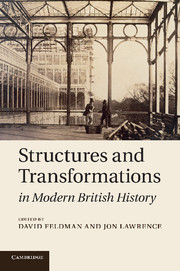Book contents
- Frontmatter
- Contents
- List of figures
- Notes on contributors
- Introduction: structures and transformations in British historiography
- 1 Coping with rapid population growth: how England fared in the century preceding the Great Exhibition of 1851
- 2 The ‘urban renaissance’ and the mob: rethinking civic improvement over the long eighteenth century
- 3 Forms of ‘government growth’, 1780–1830
- 4 Family formations: Anglo India and the familial proto-state
- 5 The commons, enclosure and radical histories
- 6 Engels and the city: the philosophy and practice of urban hypocrisy
- 7 The decline of institutional reform in nineteenth-century Britain
- 8 British women and cultures of internationalism, c.1815–1914
- 9 Psychoanalysis, history and national culture
- 10 Labour and the politics of class, 1900–1940
- 11 The dialectics of liberation: the old left, the new left and the counter-culture
- 12 Why the English like turbans: multicultural politics in British history
- Index
6 - Engels and the city: the philosophy and practice of urban hypocrisy
Published online by Cambridge University Press: 04 February 2011
- Frontmatter
- Contents
- List of figures
- Notes on contributors
- Introduction: structures and transformations in British historiography
- 1 Coping with rapid population growth: how England fared in the century preceding the Great Exhibition of 1851
- 2 The ‘urban renaissance’ and the mob: rethinking civic improvement over the long eighteenth century
- 3 Forms of ‘government growth’, 1780–1830
- 4 Family formations: Anglo India and the familial proto-state
- 5 The commons, enclosure and radical histories
- 6 Engels and the city: the philosophy and practice of urban hypocrisy
- 7 The decline of institutional reform in nineteenth-century Britain
- 8 British women and cultures of internationalism, c.1815–1914
- 9 Psychoanalysis, history and national culture
- 10 Labour and the politics of class, 1900–1940
- 11 The dialectics of liberation: the old left, the new left and the counter-culture
- 12 Why the English like turbans: multicultural politics in British history
- Index
Summary
From ‘gated communities’ to high-walled ‘urban villages’ to down-town Central Business Districts, it is now a truism of urban analysis that social relations of production dictate the spatial function of the city. Be it the security-guarded, ex-urban estates of middle-class America, the ‘inner-city’ compounds nestling in the heart of London and Mumbai, or the fortified suburban laagers which ring northern Johannesburg (modelled, it is said, on the style of Tuscan hill towns), civic space is becoming a more obviously codified commodity. Meanwhile, those urban arenas which remain open are arguably subject to an ever-more insidious process of privatisation (even militarisation) as retail districts and developers collude with councils and police authorities to lock down open parks and public squares. In Western cities, urban space has increasingly become a sotto voce battleground between private property interests, security functionaries and regeneration advocates. ‘The Royal Institution of Chartered Surveyors [has] found that the ownership and control of public realm is shifting from the public to the private sector, replicating patterns not seen since the early Victorian era – when private landlords owned and managed vast swaths of cities’, The Guardian recently announced. Even Trafalgar Square, London's symbolic space for protest and display, is now a highly controlled zone patrolled by uniformed marshals with public drinking, feeding the pigeons and splashing in the fountains strictly outlawed.
- Type
- Chapter
- Information
- Structures and Transformations in Modern British History , pp. 142 - 163Publisher: Cambridge University PressPrint publication year: 2011
- 2
- Cited by

